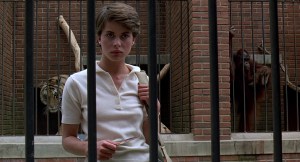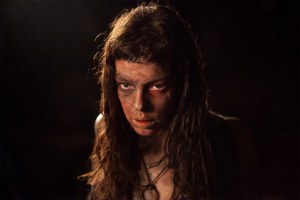The videogame community made an important outreach effort to movie nerds on Wednesday night, as representatives from Rockstar Games made the trek into Westchester County, New York, to demo their current release, the open-world Western adventure Red Dead Redemption, for the arthouse crowd. Presided over by erstwhile New York Times movie critic Janet Maslin, the game night was an unusual booking for the Burns Film Center, which is more inclined to host filmmaker chats with the likes of Werner Herzog and Jonathan Demme. Props to the powers that be at the Burns for recognizing that Red Dead Redemption is freaking awesome and giving Rockstar a venue for showing a bunch of hardcore film people (not to mention all the hip youngsters who brought hard copies of the game to be autographed by the Rockstar crew) what’s up in the increasingly expansive world of interactive entertainment.
I still feel a little silly about paying $11 for the privilege to sit through what amounts to a 90-minute live infomercial for a videogame that I’ve already paid $60 to purchase, but there was no way I was going to miss seeing Maslin get up on stage to grapple with the new media. I was worried there would be a lot of talk about the relative merits of videogames and movies as art forms (and was hoping maybe we could patch in Roger “videogames are not art” Ebert by satellite), but Maslin declined to run the discussion into that rut, opting to ask questions about the creative process behind the game rather than trying to wrap her arms around all of interactive media at once.
The evening opened with a brief promotional trailer for the game, followed by a screening of “Red Dead Redemption,” a short film by director John Hillcoat, whose distinctive Australian western, The Proposition, is apparently an acknowledged inspiration for the game. What’s unusual about the short is that it’s machinima — that is, it was created entirely through manipulation of the Red Dead Redemption videogame engine. Hillcoat was able to precisely reposition the in-game camera, re-configure the lighting, and chop up the pre-recorded narrative bits to assemble something resembling a standalone short film set in the Old West.
But the real fun came next, with a live demo of actual Red Dead Redemption gameplay. The game was running on an Xbox 360 sitting on the floor in front of the theater’s 30-foot-wide screen, and it was sort of marvelous to see that tiny piece of hardware driving a full-size cinema screen. Despite Hillcoat’s cinematic bona fides, his film was pretty drab compared to the electricity of the live gameplay experience. Audience members chuckled appreciatively as the demo artist used the game’s slo-mo targeting feature to sweep gunfire across the bodies of their adversaries, sending them spinning through the air and slamming to the ground in Peckinpah time. The guy sitting next to me with the monstrous tub of popcorn cackled at the game’s western caricatures and whimsical dialogue. And you could hear the gasps running through the crowd as Rockstar showed how the game’s hero, John Marston, could shoot and skin a deer romping blamelessly through RDR’s fully realized 3D prairie.
During the Q&A that followed, Rockstar’s head of finance and corporate development, Rowan Hajaj (at right in the crappy iPhone photo above), noted that Western-themed videogames were not, as a rule, commercially successful. The idea here was to break the mold and create a completely immersive Western experience. When Maslin asked if making a game in this genre was a conscious effort to appeal to older gamers, Hajaj said it wasn’t a driving principle. “We’ve made games for people like us — people who enjoy all kinds of media,” he said, noting some of Rockstar’s other unusual concepts, like the prep-school epic Bully.
Another Rockstar rep on stage — I believe it was International Marketing Director Simon Ramsey, but I’m not 100% sure on that point — Simon Ramsey, Rockstar’s international marketing director, noted that videogames are slowly becoming “multidisciplinary” endeavors, suggesting that as more purely creative people, rather than technical specialists, become involved in the game design process, the medium gains artistic clout. As an example, he said, the very first films were made by a select group of people who had technical and mechanical expertise with the first movie cameras. “Cinema didn’t explode until people with creative vision — but who didn’t know how to run the machines — got involved,” he said. “Games are evolving the same way film evolved.”
Still, videogames are a very different medium from cinema. Hajaj said the final script for Red Dead Redemption, when assembled, amounted to about 5,000 pages — 2,000 of them devoted to the film’s central story and another 3,000 dedicated to “ambient” dialogue in the film’s numerous peripheral side quests that can take up metric tons of a dedicated players game time. Compare that to the world of filmmaking, where a page of script is roughly equal to a minute of screen time, meaning that your typical two-hour movie has a 120-page script. Further, in addition to the sustained efforts of a small army of 3D artists and programmers, it took more than 500 voice and motion-capture actors and over five years of work to realize all of the concepts that went into Red Dead Redemption.
Asked by Maslin about the differences between the urban-crime themed and wildly popular Grand Theft Auto franchise and Red Dead Redemption, Hajaj rightly characterized the latter game as an “evolution” from Grand Theft Auto, but not a “departure.” (Players with experience in both game worlds have almost certainly noticed that the games are as similar as they are different, with many game mechanics working very similarly despite the fairly dramatic change in setting and atmosphere.) On the subject of GTA, Hajaj noted that the writing is generally handled by Brits. “GTA is mainly made in Edinburgh,” he said, explaining that the conceptual process involved, in part, loading a bunch of Scottish guys in vans and taking them around New York City to shoot reference video for the game design.
The first question from an audience member came from director Paul Schrader, who had noted that the game’s protagonist Marston, a married man, is prohibited from interacting with the prostitutes who populate the game’s saloon environs. That meant, he noted, that the game wasn’t quite as “open-ended” as an uninitiated player might hope. (In a different context, Maslin indirectly mentioned the “hot coffee” controversy that dogged one of the GTA games after an enterprising PC gamer learned how to unearth some sexually explicit content that developers had removed from the game before release while neglecting to actually delete the raw code from the software. Rockstar’s experience with that particular tempest in a teapot may have informed its approach to sex in the new game, although the restriction on Marston’s promiscuity also functions as a way to show that he is a fundamentally moral character.)
Schrader also asked about the game’s development costs and its projected gross, but was completely shut down by the Rockstar guys, who refused to talk budgets.
Later in the evening, rock-star DP Frederick Elmes (Synecdoche, New York, Blue Velvet) had his own question about the game’s meticulous environmental designs, as well as about the developers’ decision to make the time of day change as you play — morning turns to high noon turns to dusk turns to the desert night at a rate of about one minute per second of gameplay time. (In other words, if you play the game for 24 minutes, a full 24 hours will pass in the game’s world, and your character will pass from day into night and back through day again as you watch.) That came down to a desire, Hajaj said, to break the gameplay up visually. After spending time in the harsh midday light, it just made sense to give players a chance to end each day with a beautiful sunset over the prairie. Now that’s an answer that had to make sense to a cinematographer.

